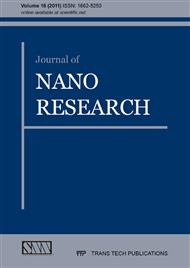[1]
Y. Tanaka, The forefront of practical superconducting wires, Physica C 335 (2000) 69-72.
Google Scholar
[2]
V. Pantsyrny, A. Shikov, A. Vorobieva, Nb3Sn material development in Russia, Cryogenics 48 (2008) 354-370.
DOI: 10.1016/j.cryogenics.2008.04.006
Google Scholar
[3]
A. Shikov, V. Pantsyrny, A. Vorobieva et al., Development of the Nb3Sn bronze strand of TF conductor sample for testing in SULTAN facility, IEEE Trans. Appl. Supercond. 19 (3) (2009) 1466-1469.
DOI: 10.1109/tasc.2009.2018055
Google Scholar
[4]
W. Schauer and W. Schelb, Improvement of Nb3Sn high field critical current by a two-stage reaction, IEEE Trans. Magn. MAG-17(1) (1981), pp.374-377.
DOI: 10.1109/tmag.1981.1060900
Google Scholar
[5]
E.N. Popova, V.V. Popov, E.P. Romanov et al., Effect of doping, composite geometry and diffusion annealing schedules on the structure of Nb3Sn layers in Nb/Cu-Sn wires, Def. & Diff. Forum Vol. 273-276 (2008), pp.514-519.
DOI: 10.4028/www.scientific.net/ddf.273-276.514
Google Scholar
[6]
W. Wu, D.R. Dietderich, J.T. Holthuis et al., The microstructure and critical currentcharacteristic of a bronze-processed multifilamentary Nb3Sn superconducting wire, J. Appl. Phys. 54(12) (1983) 7139-7152.
DOI: 10.1063/1.331985
Google Scholar
[7]
W. Schelb, Electron microscopic examination of multifilamentary bronze-processed Nb3Sn,J. Mater. Sci. 16 (1981) 2575-2582.
DOI: 10.1007/bf01113599
Google Scholar
[8]
E.N. Popova, S.V. Sudareva, E.P. Romanov, L.A. Rodionova, Fine structure of alloyedmultifilamentary composites on the A3B type components and its effect on superconducting parameters, Physics of Metals and Metallography 78(5) (1994) 520-528.
Google Scholar
[9]
A. Nikulin, A. Shikov, A. Vorobieva et al., The investigation of the effect of niobium artificial doping with titanium on Nb3Sn superconductors properties, Adv. Cryog. Eng. Materials 42 (1996) 1337-1343.
DOI: 10.1007/978-1-4757-9059-7_173
Google Scholar
[10]
Н. Sekine, Y. Iijimа еt аl., Effects of titanium addition to the matrix of Nb3Sn composites, Рrос. Intern. Cryog. Mater. Conf., Коbе (1982) 86-89.
Google Scholar
[11]
E.N. Popova, L.A. Rodionova, S.V. Sudareva et al., Titanium distribution in different constituents of Nb3Sn superconducting composites, Phys. Met. Metallogr. 75(2) (1993) 189-193.
Google Scholar
[12]
E.N. Popova, S.V. Sudareva, E.P. Romanov et al., Distribution of Ti in Nb3Sn-based composites with coupled Nb filaments, Materialovedenie (Materials Science) (Rus. ) 10 (2009) 52-57.
Google Scholar
[13]
E.N. Popova, V.V. Popov, E.P. Romanov et al., Ti redistribution in multifilamentary Nb/Cu-Sn composites, Def. & Diff. Forum 283-286 (2009) 649-656.
DOI: 10.4028/www.scientific.net/ddf.283-286.649
Google Scholar
[14]
D. Uglietti, V. Abacherli, M. Cantoni, R. Flukiger, Grain growth, morphology and composition profiles in industrial Nb3Sn wires, IEEE Trans. Appl. Supercond. 17(2) (2007) 2615-2618.
DOI: 10.1109/tasc.2007.898226
Google Scholar
[15]
E.N. Popova, E.P. Romanov, S.V. Sudareva, A15 superconducting composites and high-strength Cu-Nb conductors, Phys. Met. Metallogr. 96(2) (2003) 146-159.
Google Scholar
[16]
L.A. Rodionova, E.N. Popova, S.V. Sudareva et al., Electron microscopic investigation of the structure of NB/Cu-Sn composites with titanium modified niobium cores, Phys. Met. Metallogr. 72(6) (1991) 96-106.
Google Scholar
[17]
E.N. Popova, V.V. Popov, E.P. Romanov et al., Effect of alloying on the kinetics of the formation of superconducting layers and fine structure of the Nb/Cu–Sn composites, Phys. Met. Metallogr. Vol. 81(6) (1996) 653659.
Google Scholar
[18]
I.L. Deryagina, E.N. Popova, E.G. Zaharevskaya et al., Effect of doping mode and composite geometry on nanocrystalline structure of Nb3Sn layers in superconducting Nb/Cu-Sn composites, J. of Siberian Federal University: Physics and Mathematics (Rus. ) 4(2) (2011).
DOI: 10.1016/j.cryogenics.2014.07.007
Google Scholar



